Exploring the Intricacies of Colorless Diamonds
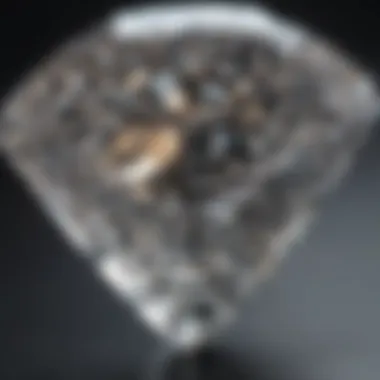
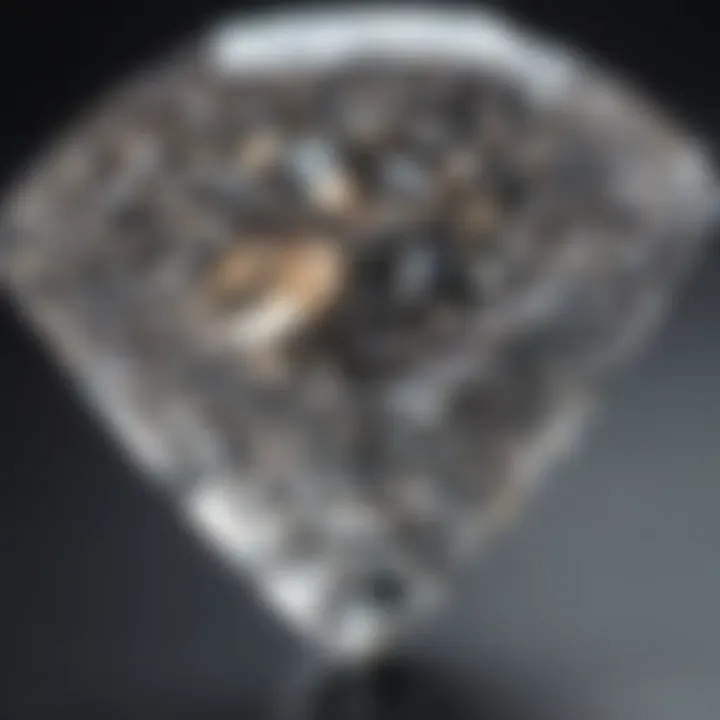
Intro
In the exploration of colorless diamonds, one enters a field that merges beauty with complexity. Colorless diamonds, often viewed as the epitome of gemstone refinement, possess unique qualities that make them not only visually captivating but also culturally significant. This article aims to unravel the diverse aspects of these stones, from their origins to their place in the modern market.
Gemstone Overview
Definition of Gemstones
Gemstones are minerals, rocks, or organic materials that have been cut and polished for ornamental use. Among these, colorless diamonds stand distinct due to their clarity and brilliance. Unlike naturally colored diamonds, colorless diamonds are known for their lack of hue, which enhances their sparkling appearance.
Classification of Gemstones
Gemstones can be broadly classified into two categories: precious and semi-precious. Colorless diamonds fall into the precious category, which also includes rubies, sapphires, and emeralds. Other than these classifications, gemstones can also be categorized based on their composition, crystal structure, and optical properties. The various forms of diamonds, including natural, synthetic, and lab-grown, are crucial to understanding their value and usability in jewelry.
Historical Significance
Origins of Gemstone Use
Historically, gemstones have been valued not only for their beauty but also for their supposed magical properties and significance in cultural rituals. The use of diamonds dates back thousands of years, with ancient civilizations seeing these gemstones as symbols of wealth and power.
Cultural Insights: Gemstones in Ancient Civilizations
In ancient India, for instance, diamonds were associated with strength and invincibility. The Greeks believed that diamonds were tears of the gods, underscoring their divine essence. Throughout history, these perceptions have persisted, shaping modern views of colorless diamonds. They continue to hold a revered place in various cultures, symbolizing love, fidelity, and prestige.
"The allure of diamonds lies not only in their physical properties but also in their historical narratives and cultural significance."
By navigating through the intricacies of colorless diamonds, one can appreciate their profound place in both the gemstone market and human history.
Prelude to Colorless Diamonds
Colorless diamonds hold a special place in the world of gemstones. Their prominence in jewelry and investment markets stems from their unique characteristics and rich history. Understanding colorless diamonds involves diving into their defining traits and past significance. Through this article, we will explore not just the aesthetic appeal of these diamonds but also their geological origins and the factors contributing to their market dynamics.
Defining Colorless Diamonds
Colorless diamonds are typically described as gemstones that lack any noticeable color. The absence of hues makes them highly sought after, especially in engagement rings and other fine jewelry. The grading system categorizes them based on their colorless or near-colorless status. The Gemological Institute of America (GIA) classifies diamonds on a scale from D to Z, where D signifies a completely colorless stone and Z indicates a notable color presence.
Key characteristics of colorless diamonds include:
- Clarity: These diamonds can be nearly flawless, allowing for maximum light reflection.
- Cut: A well-cut diamond enhances its brilliance and sparkle, making its colorlessness more pronounced.
- Carat Weight: The size of the diamond affects its overall appearance, with larger stones showcasing their colorless quality more clearly.
By examining these elements, one can appreciate the true value and beauty of colorless diamonds.
Historical Perspective
The history of colorless diamonds is intertwined with human civilization and luxury. In ancient times, diamonds were thought to possess various powers and were believed to offer protection. The allure of these stones grew over time, particularly during the reign of kings and queens who adorned themselves with diamond jewelry. Notably, the famous Hope Diamond has a rich history that exemplifies the cultural significance of colorless diamonds.
In the 19th century, the discovery of large diamond deposits in South Africa dramatically shifted the diamond market. This brought forth a new era of accessibility for these once-rare stones.
Today, colorless diamonds continue to symbolize wealth and status. Their place in popular culture is solidified through books, films, and high-profile celebrity engagements. Through time, attitudes toward these gems have evolved, driving their demand and shaping market trends.


"Diamonds are a girl's best friend" - This phrase illustrates the enduring charm of colorless diamonds, highlighting their relevance from past to present.
Formation and Characteristics
Understanding the formation and characteristics of colorless diamonds is crucial for grasping their significance in the gemstone market. These stones are not just aesthetically appealing, but their origins and properties dictate their desirability, value, and market dynamics. This section explores the geological processes that create these diamonds, along with their physical and optical attributes.
Geological Origins
Colorless diamonds, like their colored counterparts, are formed deep within the Earth’s mantle, generally at depths of 150 to 200 kilometers. High pressure and temperature conditions necessary for their formation are typically found in regions known as cratons, which are stable parts of the continental crust. This process takes billions of years.
The raw material for natural diamonds is carbon, derived mainly from organic and inorganic sources. The process begins with carbon atoms bonding in a crystalline structure. Over time, minerals and trace elements can get trapped within the diamond's structure, affecting its quality and finish.
Significantly, volcanic eruptions can transport these formed diamonds towards the Earth’s surface, often within a matrix called kimberlite. The rarity of such eruptions means natural diamonds, particularly colorless varieties, are scarce. These geological and environmental factors significantly influence each diamond's uniqueness, positioning colorless diamonds as particularly valuable collector's items.
Physical and Optical Properties
The allure of colorless diamonds lies not only in their origins but also in their physical and optical properties. They shine with a brilliance and fire that captivates buyers and collectors alike.
- Hardness: Colorless diamonds score a perfect 10 on the Mohs scale, making them the hardest natural substance known. This durability adds to their desirability for jewelry.
- Refraction: The unique crystalline structure allows for remarkable light refraction, giving rise to the brilliance associated with diamonds. When light enters a diamond, it bends, splits, and reflects, creating the mesmerizing sparkle.
- Clarity: Natural colorless diamonds may exhibit inclusions and blemishes. The clarity of a diamond significantly affects its market value and aesthetic appeal. Jewelers often utilize a grading scale to assess and describe these characteristics.
- Color Grading: While the term "colorless" implies a lack of hue, diamonds are often graded on a scale ranging from D (truly colorless) to Z (light yellow). The more colorless a diamond is, the more valuable it generally becomes.
The optical properties of colorless diamonds set them apart, enhancing their appeal. Their ability to reflect light makes them a timeless choice in jewelry, resonating with both buyers and designers.
"The interplay of light and diamond creates an optical phenomenon like no other. A well-cut diamond will refract and reflect light in a way that results in a dazzling display that captures the eye."
In summary, the formation and characteristics of colorless diamonds highlight their rarity and desirability. Understanding these facets provides a solid foundation for appreciating the stone's intricate beauty and market value.
Natural vs. Synthetic Colorless Diamonds
The distinction between natural and synthetic colorless diamonds is of significant importance in the study of these gemstones. Each type presents unique characteristics that appeal to different segments of the market. Moreover, understanding this distinction can help consumers make informed decisions based on their preferences, values, and budgets.
Natural Diamonds: Formation and Rarity
Natural colorless diamonds originate through geological processes that unfold over millions of years. These processes include high pressure and temperature conditions found deep within the Earth’s mantle. As carbon atoms crystallize, they form the clear, brilliant diamonds we carry in our jewelry. The rarity of natural diamonds adds to their allure and status as valuable assets. The mining of these diamonds demands significant investment in exploration and extraction techniques, contributing to their overall market value. Areas like South Africa, Russia, and Australia are known for their natural diamond yields. Each stone carries a tale of nature's power, making ownership more desirable for many buyers.
Synthetic Diamonds: Technology and Production
Synthetic colorless diamonds are created using advanced technological processes, notably High Pressure High Temperature (HPHT) and Chemical Vapor Deposition (CVD). These methods replicate the conditions necessary for diamond formation. They yield stones that are chemically and physically similar to their natural counterparts. The production of synthetic diamonds allows for more controlled characteristics and reduced environmental impact. Importantly, synthetic options can be offered at lower price points, making them appealing to budget-conscious consumers. Brands, including OMI Gems and Diamond Foundry, specialize in producing lab-grown diamonds, which are increasingly gaining traction in the jewelry market.
Key Differences and Consumer Perceptions
The key differences between natural and synthetic colorless diamonds extend beyond their origins.
- Rarity: Natural diamonds are inherently rare, whereas synthetic diamonds can be produced in quantity.
- Price: Generally, synthetic diamonds are less expensive compared to natural diamonds, making them more accessible.
- Resale Value: Natural diamonds tend to retain their value better in the resale market compared to synthetic stones.
- Ethical Considerations: Synthetic diamonds are often marketed as ethical alternatives, as they avoid the environmental and social issues associated with some mining practices.
Consumer perceptions vary widely. Some individuals view natural diamonds as symbols of prestige and tradition. Others appreciate synthetic diamonds for their ethical implications and affordability.
"Understanding these differences helps consumers align their purchases with their values and financial statements."
Grading Colorless Diamonds
Grading colorless diamonds is crucial in understanding their quality and value. This section unpacks the nuances of diamond grading, focusing on how it impacts both buyers and sellers. An accurate grading system guides consumers in making informed decisions when purchasing these gemstones. It also helps jewelers and collectors in establishing fair market values, ensuring the integrity of transactions in this competitive industry.
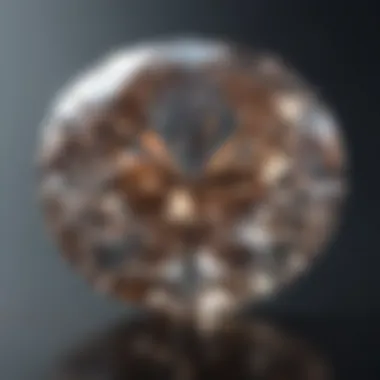
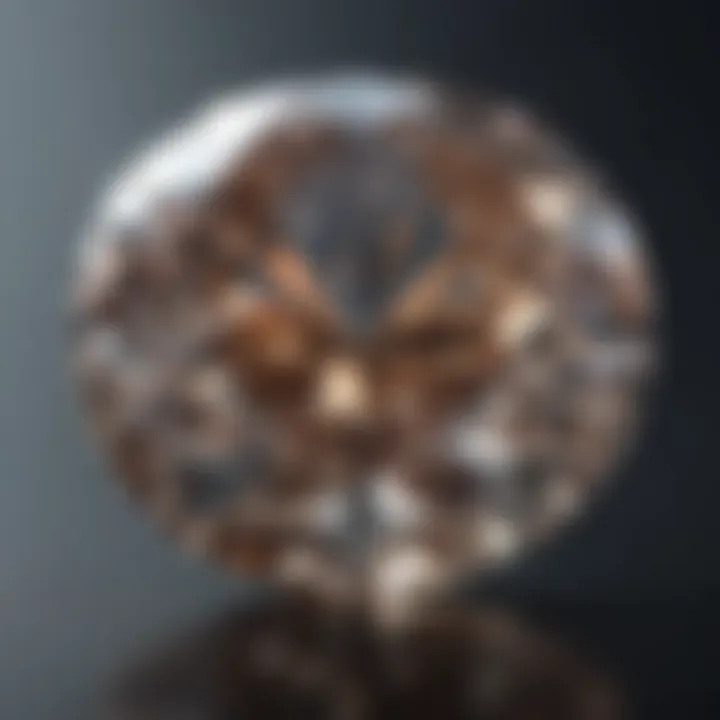
Understanding the Four Cs
The Four Cs stand for Carat, Cut, Color, and Clarity. These criteria serve as the foundation for grading diamonds.
- Carat: Refers to the weight of the diamond. A higher carat weight usually indicates a larger and more valuable stone, but size is not the only factor impacting value.
- Cut: This describes how well a diamond has been shaped and faceted. A well-cut diamond reflects light beautifully, enhancing its brilliance. Poorly cut stones may appear dull, regardless of their other attributes.
- Color: In the context of colorless diamonds, this means the absence of color. The best stones are completely colorless, rated D on a scale from D to Z, where Z shows noticeable color.
- Clarity: This evaluates the presence of imperfections or inclusions within the diamond. Higher clarity grades indicate fewer flaws, which means the stone is more likely to remain visually appealing.
Understanding the Four Cs provides a comprehensive base from which to evaluate diamonds. Moreover, they serve as the standard metrics that guide both appraisal and market valuation.
Color and Clarity Ranges
In the grading system, color and clarity are vital. Small variations can have significant impacts on value.
- Color Ranges: Colorless diamonds (D to F) command higher prices as they reflect more light. Colors like G to J, while still near colorless, offer more affordability without significant visual detriment. Diamonds rated K and below might show noticeable color; their value can drop steeply.
- Clarity Ranges: The clarity scale ranges from Flawless (no inclusions visible) to Included (inclusions noticeable to the naked eye). Generally, stones with higher clarity rankings (e.g., IF or VVS) are sought after by collectors for their aesthetic qualities. The presence of visible inclusions can affect the diamond's marketability.
A comprehensive understanding of both color and clarity ranges allows consumers to make better choices based on their budget while still attaining quality stones.
Impact on Value and Marketability
Grading directly influences both value and marketability. Diamonds that exhibit optimal characteristics in the Four Cs often command higher prices.
- Value: The combined effect of weight, cut, color, and clarity determines the retail price. Consumers often see value in higher quality stones, while jewellers appreciate having a grading system to standardize pricing.
- Marketability: Graded diamonds provide consumers with reassurance regarding quality. The certification by recognized grading laboratories, such as the Gemological Institute of America (GIA), reinforces trust in the buying process. This assurance aids market liquidity, as consumers are more willing to invest in stones with verified quality.
Market Trends and Consumer Demand
Understanding the market trends and consumer demand for colorless diamonds is vital in comprehending their significance in today's gemstone industry. These trends reveal the changing preferences of buyers, how these preferences shape market conditions, and the implications for both sellers and buyers. As consumers become more informed and discerning, their choices reflect broader societal values, such as sustainability, ethical sourcing, and individual expression.
Current Market Dynamics
The market for colorless diamonds has seen fluctuations due to various factors. Economic conditions, like inflation and recessions, can significantly impact luxury purchases. However, despite economic uncertainties, the desire for colorless diamonds has remained resilient. The global market reflects a complex interplay of demand driven by cultural influences, economic stability, and advertising.
Recent reports indicate a rise in online jewelry sales. COVID-19 has accelerated this trend, as consumers shifted to e-commerce platforms for their diamond purchases. Retailers must adapt to these dynamics, enhancing their online presence and providing detailed information about their products to meet consumer expectations. Buyers are more likely to conduct thorough research before making purchases, which emphasizes the importance of transparent and informative marketing strategies.
In addition, the introduction of augmented reality tools allows customers to virtually try on rings and other jewelry, further influencing their buying decisions. Integrating technology into the buying experience creates a seamless connection between a consumer's desire and the product offered, leading to improved sales outcomes.
Shifts in Consumer Preferences
Consumer preferences in the diamond market have shifted noticeably. Younger generations, particularly Millennials and Generation Z, prioritize ethical sourcing and sustainability. They desire assurance that their diamonds are conflict-free and produced under responsible environmental practices. This shift emphasizes the importance of transparency in the supply chain.
Moreover, personalization is becoming increasingly important. Custom designs, unique cuts, and even alternative gemstones are gaining traction among consumers. Besides the classic colorless diamonds, some buyers are exploring options like lab-grown diamonds — a concept that appeals to a portion of environmentally-conscious shoppers.
"The preferences of buyers are not strictly about aesthetics; they also reflect values and beliefs."
Understanding such preferences can be a game-changer for jewelers. Offering options that align with buyer values positions retailers favorably in an evolving market landscape. As more consumers educate themselves on the differences between natural and lab-grown diamonds, jewelers who provide comprehensive information and cater to individual preferences will likely capture a greater market share.
The Role of Colorless Diamonds in Jewelry
Colorless diamonds hold a significant place in the world of jewelry. Their unique features, brilliant shine, and cultural associations make them a popular choice for various types of adornments. The appeal of these gems extends beyond mere aesthetics. They symbolize love, commitment, and often, status. Understanding their role in jewelry design and consumer choice is vital for both enthusiasts and investors.
Classic Engagement Rings
Colorless diamonds are the epitome of engagement ring standards. The tradition of using these stones began many decades ago, establishing a benchmark for what many consider the perfect ring. The clarity and light performance of colorless diamonds enhance their desirability, leading them to be perceived as a true representation of love and commitment.
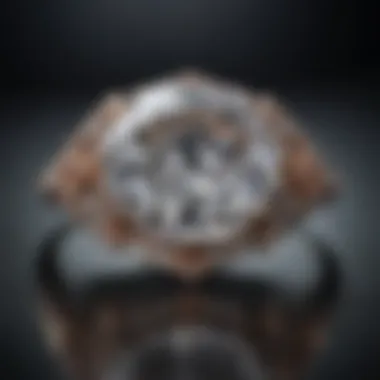
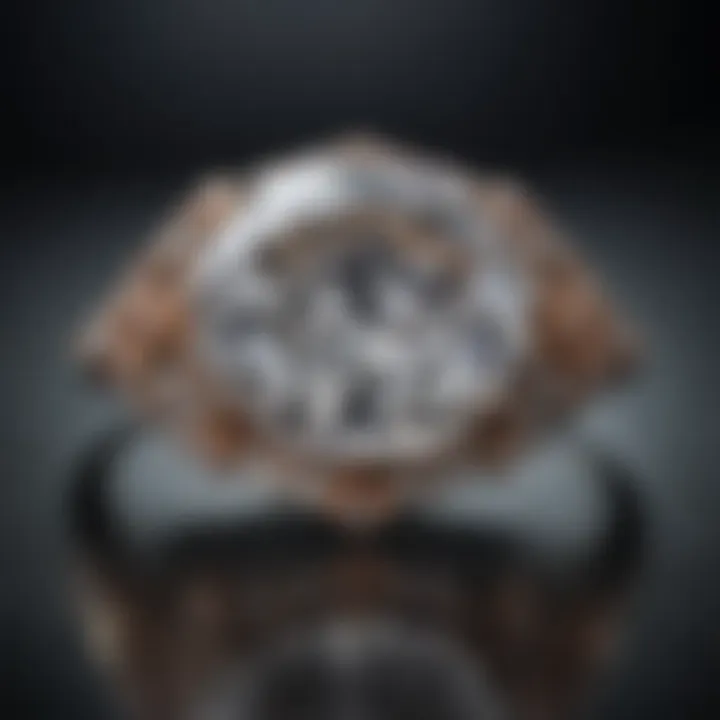
When selecting a colorless diamond for an engagement ring, several factors come into play:
- Cut Quality: This affects how much light the diamond reflects. A well-cut diamond exhibits excellent brilliance, increasing its allure.
- Clarity: Flawless stones are rare and highly sought after, as they signify purity and perfection.
- Carat Weight: Larger diamonds naturally attract more attention, but the cut and clarity matter more to many.
A colorless diamond in a classic solitaire setting is often the most favored choice. This simplicity allows the beauty of the diamond to shine through without distraction. Other styles, like halo settings, pair the center stone with smaller diamonds, amplifying the overall glimmer and appeal. Thus, it is clear that colorless diamonds are integral to the engagement ring narrative, representing timeless elegance and tradition.
Innovations in Design
As trends evolve, so does the way colorless diamonds are incorporated into jewelry. Modern designers explore innovative methods to showcase these stones. No longer confined to the traditional rings, colorless diamonds now find their way into various pieces, including earrings, necklaces, and bracelets.
- Alternative Cuts: Beyond round brilliant cuts, designers use fancy shapes such as pear, oval, and radiant. These cuts can offer unique visual appeal, catering to diverse tastes.
- Mixed Materials: Increasingly, designers pair colorless diamonds with different metals or gemstones, creating a fresh aesthetic. The contrast of color, materials, and texture adds an artistic touch.
- Sustainable Practices: In response to environmental concerns, some designers focus on ethically sourced or lab-created colorless diamonds. This approach appeals to a conscientious consumer base, merging beauty with responsibility.
In summary, colorless diamonds play a crucial role in the jewelry market, with their significance spanning traditional engagements and contemporary design innovations. Their versatility ensures they remain a coveted choice in both timeless and trendy collections.
The allure of colorless diamonds is not merely about their look but also what they represent in terms of value, sentiment, and craftsmanship.
Investment Considerations
Investment in colorless diamonds has become an intriguing topic for both seasoned collectors and new buyers alike. As these gems are often seen as a store of value, understanding various investment considerations is essential for making informed decisions. The allure of colorless diamonds lies not only in their beauty but also in their potential for value appreciation over time. Key aspects to consider include evaluating value retention, market liquidity, and resale potential.
Evaluating Value Retention
When contemplating an investment in colorless diamonds, one must assess how well these diamonds hold their value. Several factors influence value retention:
- Quality of the Diamond: Higher quality diamonds, such as those graded with excellent cut, clarity, and color, tend to retain value better.
- Market Trends: The demand for colorless diamonds fluctuates based on market conditions, affecting their subsequent resale prices.
- Certification: Diamonds certified by reputable organizations like the Gemological Institute of America (GIA) often have better value retention.
Investors should take time to analyze these aspects as they can significantly impact future worth. Investment in colorless diamonds can lead to stability in one's portfolio if approached with careful consideration of these factors.
Market Liquidity and Resale Potential
Market liquidity refers to how easily a diamond can be sold at its current value. This is a crucial aspect of any investment, particularly in gemstones. The popularity of colorless diamonds contributes to their relative liquidity, but the following points should be considered:
- Target Audience: Knowing the potential buyers in the market can help predict resale opportunities.
- Platform of Sale: Selling through auctions, private sales, or retail channels can yield different results in terms of pricing and ease of sale.
- Condition and Documentation: Diamonds that come with complete history and documentation are generally more appealing to future buyers.
Moreover, understanding the fluctuations in market demand for colorless diamonds will aid investors in making educated decisions regarding their investments. Timing can play a vital role in achieving favorable resale conditions.
"Investing in colorless diamonds requires a blend of artistry and market insight; both are essential for maximizing returns."
Culmination
The examination of colorless diamonds within this article underscores their intricate nature and expansive significance in the gemstone market. By delving into their formation, grading, and current market trends, we have painted a comprehensive picture of what constitutes a colorless diamond and why these stones hold considerable value to both collectors and investors.
Summary of Key Points
Throughout this article, we have discussed various aspects that contribute to the allure of colorless diamonds:
- Defining Colorless Diamonds: Understanding what characterizes these gems goes beyond their visual clarity; it involves recognizing their geological origins and how they differ from other diamonds.
- Natural vs. Synthetic: We detailed how natural diamonds are formed through geological processes while synthetic counterparts are produced in labs. This distinction plays a pivotal role in market valuation.
- Grading Systems: The Four Cs—Carat, Cut, Color, and Clarity—offer vital insights into a diamond's quality, directly influencing appeal and pricing.
- Market Trends: Consumer preferences are shifting towards sustainability and ethical sourcing, affecting how colorless diamonds are perceived in today’s market.
- Investment Considerations: Evaluating value retention and market liquidity is essential for investors looking to buy colorless diamonds.
Each of these points not only enhances our understanding but also informs potential decisions, whether in purchasing, collecting, or investing.
Future Outlook for Colorless Diamonds
Looking ahead, the market for colorless diamonds is poised for several developments. The growing interest in synthetic diamonds may alter market dynamics, as consumers become more aware of ethical implications and environmental considerations. Moreover, advancements in technology could lead to more precise grading and valuation methods, enhancing transparency.
The demand for unique and ethically sourced gemstones will likely continue to shape the future of colorless diamonds. Additionally, as the global market evolves, new opportunities for innovative designs and settings can be expected. This evolving landscape will challenge stakeholders to stay informed about trends and adapt their strategies accordingly.
In summary, the future bodes well for colorless diamonds, suggesting an ongoing evolution that meshes tradition with modern consumer values and technological advances.



